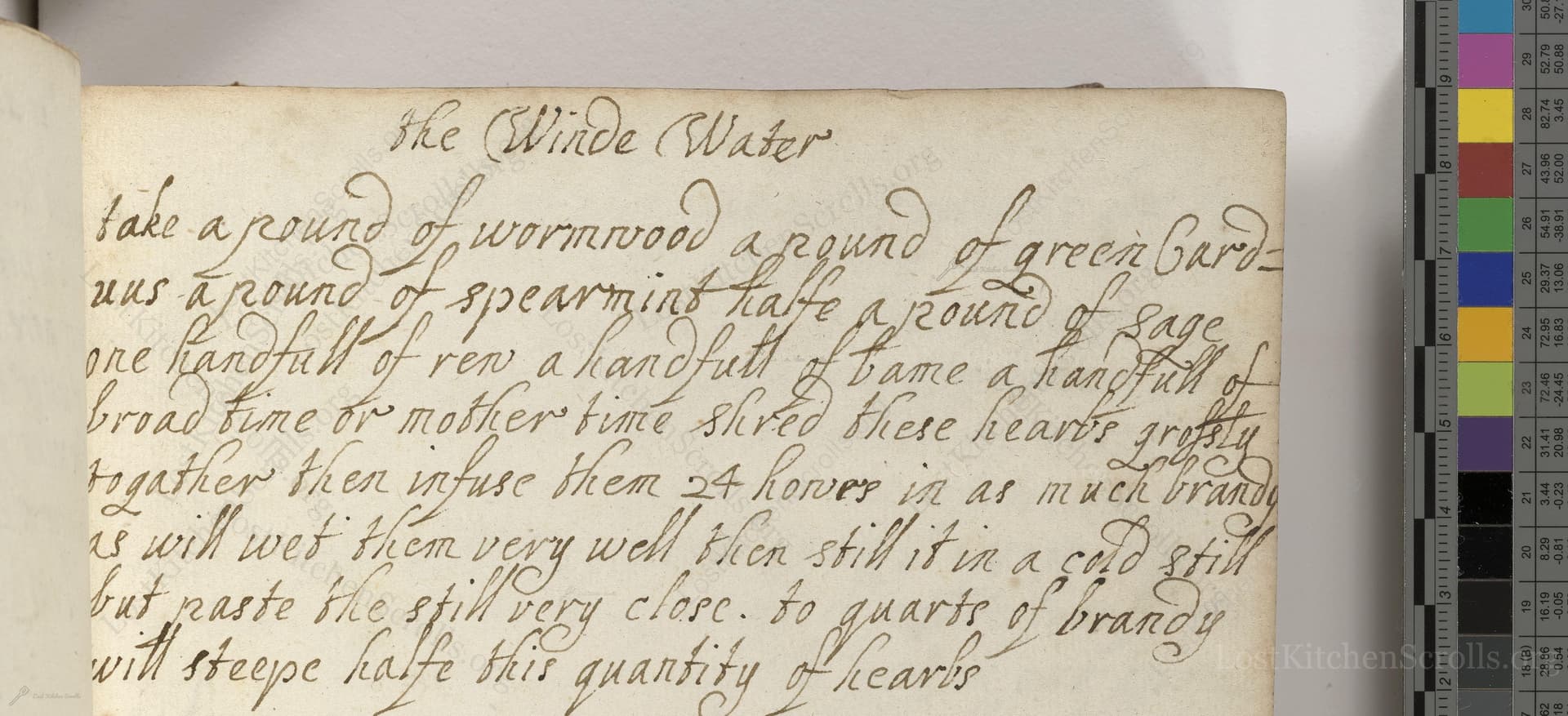The Blinde Water
From the treasured pages of Culinary and medicinal recipe book of Mary Smith
Written by Mary Smith

The Blinde Water
"take a pound of wormwood a pound of green Cardnus a pound of spearmint halfe a pound of Sage one handfull of rew a handfull of fame a handfull of broad time or mother time shred these hearbs greatly togather then infuse them 24 hours in as much brandy as will wet them very well then still it in a cold still but paste the still very close. so quarts of brandy will steepe halfe this quantity of hearbs"
Note on the Original Text
This recipe is concise and measured by weight and handfuls rather than specific milliliters or grams, typical of early modern English manuscripts. Spelling variants ('Cardnus' for carduus, 'rew' for rue, 'broad time' for thyme), and the phrase 'fame' (likely a corruption or lost herb, substituted with savory if at all) reflect period orthography and botanical knowledge. The directions are practical, assuming intimate acquaintance with the operation of a 'cold still' and the use of fresh herbs. Quantities are tied to what could be easily gathered, rather than purchased, which hints at the kitchen garden's central role in early household medicine.

Title
Culinary and medicinal recipe book of Mary Smith (1662)
You can also click the book image above to peruse the original tome
Writer
Mary Smith
Era
1662
Publisher
Unknown
Background
A delightful window into 17th-century kitchens, this cookbook serves up recipes and culinary wisdom from a bygone era, inviting readers to savor the flavors and traditions of the past.
Kindly made available by
Folger Shakespeare Library
This intriguing herbal infusion, known as 'Blinde Water,' appears in the recipe notes of Mary Smith circa 1662, during England’s restoration era. Such herbal waters were popular for both medicinal and convivial purposes, with wormwood, rue, and carduus etching bitter and restorative profiles beloved by 17th-century apothecaries. In a time before reliable water supplies or modern medicine, spirits infused with bitter roots and leaves gained a reputation for preventing illness, aiding digestion, and 'purging humours.' The housewife or steward might use such a water as a tonic, perhaps even as a component in early punch or cordial traditions. The presence of potent botanicals like wormwood and rue (in moderate quantities) demonstrates both the era's sophisticated herbal knowledge and its cavalier approach to potent flavors and even toxicity.

The recipe would have required a sharp knife for shredding herbs, a large earthenware or wooden bowl for mixing, and a cold (non-heated) still—commonly made of copper or pewter for home distillation. The still would be sealed with a simple paste of flour and water, pressed around the lid's rim to keep vapors in. After infusion, the entire mix is poured into the still, the lid secured, and the distillation is done by gentle condensing, not direct heat—allowing delicate aromas to collect without burning. The finished herbal water would be stored in glass or stoneware bottles, tightly stoppered.
Prep Time
30 mins
Cook Time
1 hr
Servings
40
We've done our best to adapt this historical recipe for modern kitchens, but some details may still need refinement. We warmly welcome feedback from fellow cooks and culinary historians — your insights support the entire community!
Ingredients
- 1 lb fresh wormwood (or dried, about 5 oz)
- 1 lb fresh green carduus (milk thistle, or substitute fresh artichoke leaves/thistle)
- 1 lb fresh spearmint
- 8 oz fresh sage
- 1 oz fresh rue (with extreme caution, or substitute fresh rosemary)
- 1 oz fresh summer savory (or omit if unavailable)
- 1 oz fresh broad thyme or 'mother thyme' (common or wild thyme)
- 1 - 1.25 quarts brandy (adjust to cover herbs)
Instructions
- Begin by finely shredding together 1 lb of fresh wormwood (Artemisia absinthium), 1 lb of green carduus (commonly milk thistle, but artichoke leaves or thistles can be used if unavailable), 1 lb of fresh spearmint, 8 oz of sage, one generous handful (about 1 oz) of rue (Ruta graveolens, be careful—see context), a handful (1 oz) of what is likely 'fame' (possibly savory; use summer savory or omit), and a large handful (about 1 oz) of broad thyme or mother thyme (common or wild thyme).
- Mix all the shredded herbs in a large bowl.
- Pour over enough brandy (at least 1 to 1.25 quarts) to thoroughly wet the herbs.
- Cover and leave to infuse for 24 hours.
- Then, distil the mixture using a cold still, sealing the still with dough to prevent evaporation.
- The resultant liquid is your 'Blinde Water.' If scaling the recipe down, use about 1.25 pints of brandy per half quantity of herbs.
Estimated Calories
75 per serving
Cooking Estimates
Preparing and shredding the herbs takes about 30 minutes. The infusion step requires 24 hours for the herbs to soak in the brandy. Distilling may take around 1 hour. Each serving is a small measure due to the potency and high alcohol content—about 30ml per serving.
As noted above, we have made our best effort to translate and adapt this historical recipe for modern kitchens, taking into account ingredients nowadays, cooking techniques, measurements, and so on. However, historical recipes often contain assumptions that require interpretation.
We'd love for anyone to help improve these adaptations. Community contributions are highly welcome. If you have suggestions, corrections, or cooking tips based on your experience with this recipe, please share them below.
Join the Discussion
Rate This Recipe
Dietary Preference
Main Ingredients
Culinary Technique
Occasions

Den Bockfisch In Einer Fleisch Suppen Zu Kochen
This recipe hails from a German manuscript cookbook compiled in 1696, a time whe...

Die Grieß Nudlen Zumachen
This recipe comes from a rather mysterious manuscript cookbook, penned anonymous...

Ein Boudain
This recipe comes from an anonymous German-language manuscript cookbook from 169...

Ein Gesaltzen Citroni
This recipe, dating from 1696, comes from an extensive anonymous German cookbook...
Browse our complete collection of time-honored recipes



